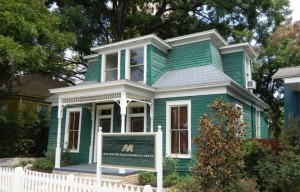Corrected: Homes could thwart convention center project
Monday, February 29, 2016 by
Elizabeth Pagano On Monday, the Historic Landmark Commission heard a proposal that could move three of downtown Austin’s oldest homes to make way for development surrounding its largest hotel.
Doug Manchester from the Manchester Texas Financial Group presented his plan to move two, possibly three, homes across the street from their current location at 604, 606 and 608 E. Third St. downtown. The Wedding House at 604 E. Third St. is zoned historic.
The homes would join the Castleman-Bull house, which was moved to the site several years ago, and the Trask House.
Manchester told the commission that if the three homes remained in place, it would prevent his company from moving forward with the development “altogether.” But several commissioners pointed out that relocation would eliminate the historic integrity needed to landmark the buildings.
The development in question is a big one. It will surround the $370 million Fairmont Austin hotel which is slated to have 1,066 rooms in its 37 stories at East Cesar Chavez and Red River streets. The hotel, which broke ground late last week, will connect to the Austin Convention Center downtown, and the millions it will contribute in property and hotel occupancy taxes will largely fund improvements to the Waller Creek Tunnel project, according to the Austin American-Statesman.

Though the proposal to move the homes was not yet up for a vote on Monday, commissioners weighed in on the plan during a briefing. Commissioner Emily Reed, for one, didn’t seem too taken with it.
“I think we kind of run the risk of creating a historical petting zoo downtown to make room for very profitable development,” said Reed.
Manchester said that he understood her concerns but objected to the petting zoo analogy. He said it discredited the talent and work that had been put into the project.
“I don’t want to create a Disneyland effect by any means,” said Manchester, who referenced historic maps that showed houses like the ones in question that once stood on their proposed new location.
“That was convincing enough evidence from my standpoint to say, look, this is really not changing the historical context, but it’s really a renovation and a restoration to what it was before,” said Manchester. “I just don’t think you are actually going to be compromising the integrity of the historical context by what we are proposing to do.”
“Well,” said Chair Mary Jo Galindo, “you are totally wrong, because you would be.
“You are taking a historic home and, even though you are moving it across the street, it’s still destroying the integrity of that building,” she continued. “And no amount of dressing it up again or whatever you would do across the street is going to change that.”
Commissioner Arif Panju also made his feelings clear.
“I think what you are seeing on full display is how often the issue of historic preservation is invoked to bring things to a screeching halt,” said Panju. He observed that he has seen a lack of flexibility in historic preservation and a lack of consideration about historic preservation on the part of developers. He encouraged both sides to be more open.
“I would hate to see the lack of flexibility from purists blocking this sort of project,” said Panju. “What I would love to see is all these historic homes becom(ing) short-term rentals in the shadows of the big hotels, … but I digress.”
Commissioner Madeline Clites agreed that the historical integrity of the buildings would be lost if they were removed from their context but also advocated for a pragmatic approach. She said she was afraid the city could lose two historic buildings that were not protected and that it would be difficult to initiate historic zoning on them against the wishes of the owner.
“And, if I’m being honest, those buildings are already out of context,” said Clites. “I hate to set another precedent to relocate and then designate, but I think this site is already compromised, so we can’t look at it as a black-and-white issue. I hate to think of it as making a deal, but I do think that it might be worth considering.”
However, Manchester pointed out that at least one of the homes had been moved in the (distant) past. He pushed for what he categorized as a win-win scenario for the entire area that could earn approval from the Waller Creek Conservancy, Convention Center and Historic Landmark Commission.
“It would be, frankly, a tragedy if this development did not move forward because of an issue I feel we really could have resolved together,” said Manchester.
Manchester said that he had taken to heart earlier comments from the Historic Landmark Commission appropriateness committee and the Convention Center, which had endorsed his plan. He encouraged commissioners to let the proposal “marinate” in their minds over the next month. It is scheduled to return to the commission on March 28.
Photos of 608 E. Third (top) and 606 E. Third (right) provided by the city of Austin.
This story has been significantly corrected. The project in question is not, in fact, the Fairmont hotel, but an adjacent project being developed in conjunction with the hotel and the redevelopment of Palm Park.
You're a community leader
And we’re honored you look to us for serious, in-depth news. You know a strong community needs local and dedicated watchdog reporting. We’re here for you and that won’t change. Now will you take the powerful next step and support our nonprofit news organization?







